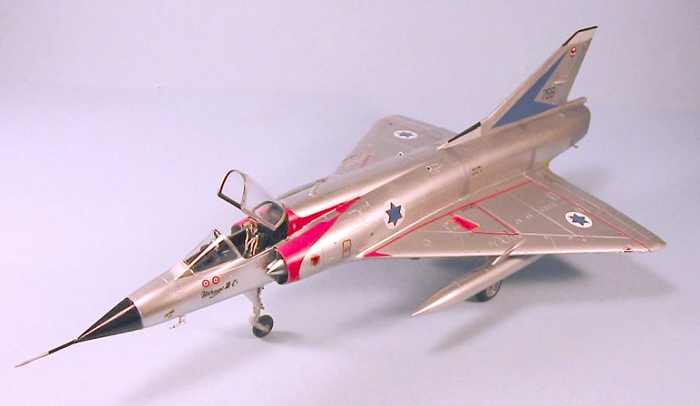
|
KIT: |
Eduard 1/48 Dassault Mirage IIICJ |
|
KIT # |
8102 |
|
PRICE: |
$44.95 MSRP |
|
DECALS: |
See Review |
|
REVIEWER: |
Tom Cleaver |
|
NOTES: |

|
HISTORY |
Marcel Dassault, known before the Second World War as Marcel Bloch, was arguably Europe’s best aircraft designer of the middle years of the 20th Century, tied with Sydney Camm of Hawkers. Returning from German prison camps - where he had been held under death sentence for his Jewish religion - he adopted the Nomme de Guerre Dassault used by his brother in the French Resistance, and started another airplane company.
Seeing jet propulsion as the wave of the future, he got into the most advanced sectors as rapidly as possible by producing the deHavilland Vampire under license. In 1950, he mated the British Nene engine with his first original jet-powered design, to create the Ouragan, which was the first domestically-designed and produced jet fighter of the Armee de l’Air. This was further developed into the Mystere series, which was the first domestic Western European design to equal the F-86 Sabre and MiG-15 in performance. The Mystere IV was utilized by the Israeli Air Force during the Suez War of 1956, where it demonstrated clear superiority over the Egyptian-flown MiGs. This led to the development of the Super Mystere, which was the first European fighter design to be capable of supersonic speed in level flight.
Unlike the development line that began with the Ouragan and is still operational today with the Super Etendard, the development of Dassault’s other major line of combat aircraft was entirely fortuitous, the result of an attempt to capitalize on a popular theory of aircraft development which - other than the creation of this remarkably successful series of fighters - was largely a developmental dead-end elsewhere.
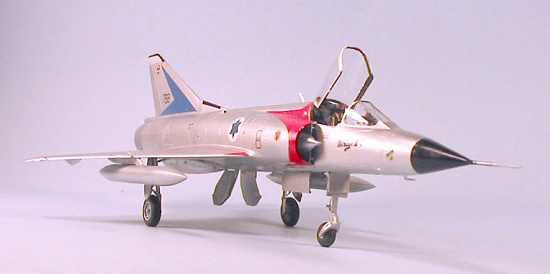 By the early
1950s, aircraft designers and some air force planners were dismayed by
the growth in size and complexity of combat aircraft brought about by the
introduction of jet propulsion. Previously, combat aircraft for all their
technological sophistication were simple enough they could be purchased
in large quantity, which was still seen as the way to operate an air
force in light of the lessons of the Second World War; countless
arguments were made that soon the standard combat airplane would be so
complex and expensive it would be unaffordable. This line of reasoning
was strongly held by designers like Kelly Johnson and Ed Heineman in the
U.S., and Teddy Petter in the UK.
By the early
1950s, aircraft designers and some air force planners were dismayed by
the growth in size and complexity of combat aircraft brought about by the
introduction of jet propulsion. Previously, combat aircraft for all their
technological sophistication were simple enough they could be purchased
in large quantity, which was still seen as the way to operate an air
force in light of the lessons of the Second World War; countless
arguments were made that soon the standard combat airplane would be so
complex and expensive it would be unaffordable. This line of reasoning
was strongly held by designers like Kelly Johnson and Ed Heineman in the
U.S., and Teddy Petter in the UK.
In 1953, the French Air Ministry issued a specification for a lightweight interceptor capable of supersonic speed. Dassault replied with what became known as the Mirage I, a very small lightweight fighter powered by two small jet engines that was capable of March 1.2. While it met all specifications, the resulting aircraft was deemed not really capable of further operational development, and led to the creation of the Mirage II, which was some 30 percent larger and introduced the ATAR turbojet. This was capable of Mach 1.6 and came close to gaining production, but was outshone by the Mirage III, which had a redesigned delta wing and was capable of Mach 2.2.
Production Mirage IIICs first appeared in 1960, with 96 on order for the Armee de l’Air. The Israelis, who were then still able to get support from the new DeGaulle government, ordered 72 known as the Mirage IIICJ, while the South Africans ordered 16 as the Mirage IIICZ.
At the time of the Six Day War in June 1967, the Mirage IIICJ was the first-line fighter of Heyl ha’Avir, the IDF/AF. The performance of the Mirages in the Israeli air strikes against the Arab air forces on the first day of the war clearly established the airplane as world-class as the two 30mm DEFA cannons in each cut like a scythe through the Egyptian and Syrian air forces, on the ground and in the air.
The Six-Day War:
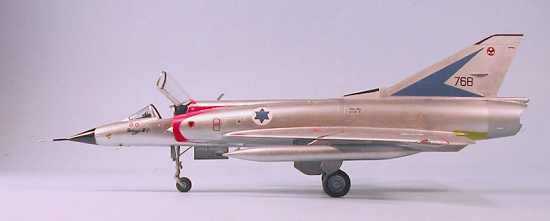 Like the
Spitfire and the Battle of Britain, the P-51 and the daylight battles
over Germany, and the F-86 over MiG Alley, the Mirage III is indelibly
connected to the Six Day War.
Like the
Spitfire and the Battle of Britain, the P-51 and the daylight battles
over Germany, and the F-86 over MiG Alley, the Mirage III is indelibly
connected to the Six Day War.
It is generally considered that Egypt initiated the crisis leading to the 1967 war by taking actions in April 1967 which forced the Israelis to plan a preventive war to avoid destruction. In the view of many Middle East specialists, Israel may have instigated the crisis by fooling the intelligence
agencies of the Soviet Union with a disinformation campaign regarding Israeli military intentions. Soviet diplomats in turn led both Syria and Egypt to believe that Israel was massing troops to attack Syria, prompting Nasser to begin preparations to come to Syria's aid. President Nasser obviously overreacted in the spring of 1967 by asking that the United Nations forces in the Sinai Peninsula separating Egyptian and Israeli troops be withdrawn. This suddenly put Egyptian forces back in control of the Strait of Tiran, at the mouth of the Gulf of Aqaba, which Nasser then declared closed to Israeli shipping, a move unacceptable to Israel. It also was unacceptable to the U.S., which had secretly guaranteed - when it forced Israel to withdraw from the Sinai in 1956 - that the strait would remain open.
Nasser's "mindset" at the time may have influenced his actions. This was that the United States was “out to get him." Looking back at the events of 1965 and 1966, Nasser's conclusion is understandable. U.S. wheat deliveries had been withheld; re‑scheduling of Egypt's debts was delayed; U.S.‑promised grain silos went unbuilt, and then‑Secretary of State Dean Rusk did not make a promised visit to Cairo. Nasser's own fiery rhetorical attacks on U.S. Middle East policies further weakened his cause in the United States.
Whoever was ultimately responsible for the outbreak of war, most observers agree that the Six Day War in 1967 marked the end of Nasser's Pan‑Arab dream. The rivalry and distrust between President Nasser and his unrealistic military commander, Marshall Abdul Hakim Al‑Amr, played a big role, with Amr thinking that the Egyptian armed forces could defeat Israel.
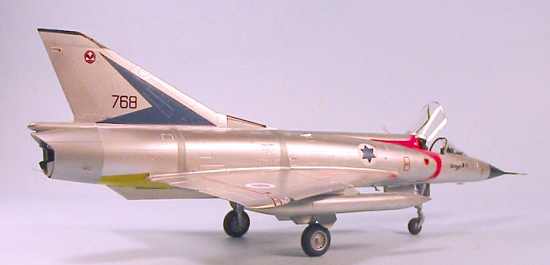 By June 1967,
the Arab‑Israeli situation had deteriorated to the point of no return.
After the UN peacekeeping force in the Sinai peninsula had been withdrawn
at Nasser's request, and Egyptian guns blockaded the Gulf of Aqaba to
Israeli ships, denying their access to the port of Eilat, Israel attacked
Egypt and in six days of combat occupied the entire Sinai Peninsula up to
the Suez Canal.
By June 1967,
the Arab‑Israeli situation had deteriorated to the point of no return.
After the UN peacekeeping force in the Sinai peninsula had been withdrawn
at Nasser's request, and Egyptian guns blockaded the Gulf of Aqaba to
Israeli ships, denying their access to the port of Eilat, Israel attacked
Egypt and in six days of combat occupied the entire Sinai Peninsula up to
the Suez Canal.
President Nasser had left his air force totally unprotected on the ground from possible Israeli air attacks, while engaged in verbal threats and menacing maneuvers against Israel. The Israelis, on the other hand, had been planning such a blow for five years, believing war to be inevitable with the only question being when it would break out.
On the first day of the war, June 5, 1967, the IDF/AF staged what has come to be considered the most successful strategic air attack ever delivered. At 0710, Israeli time, 16 armed Fouga Magisters took off from Hatzor, transmitting on frequencies used by Super Mystere and Mirage jets, and flew a routine patrol pattern at standard altitude.
At 0714, Dassault Ouragan and Mystere fighter-bombers left Hatzor, followed five minutes later by the Mirages of 119 Squadron at Ramat David, with another 15 Vautours from Hatzerim.
These aircraft headed west into the Mediterranean at wave-top height, their targets the air bases of Faid and Kibrit. By 0730, a total of 200 aircraft were airborne. The aircraft flew at no more than 15 meters above the Sinai desert and the Red Sea as they headed into Egyptian airspace. While the Super Mystere, Mystere, Ouragan and Vautour aircraft were armed with bombs and rocket packs, the Mirages were ready for air-to-air combat, carrying supersonic fuel tanks and their gun armament only. Strict radio silence was observed, with only hand-signals used between aircraft.
Virtually no
one inside Israel outside of the Air Force planning staff knew more than
a bare outline of the plans for Operation Focus. Israeli intelligence
was so good they knew the location of every airplane in the Egyptian Air
Force and even the name of the assigned pilot; much of this had been
gained by  Wolfgang Lotz, a German-born Israeli spy who had posed as a
former SS officer in order to gain vital details from the Egyptian
military leaders he befriended prior to his capture in 1964. Other
high-placed spies included Ali al-Alfi - Nasser’s personal masseur - and
provided what Air Force Commander Matti Hod later called “Israel’s
real-time intelligence.”
Wolfgang Lotz, a German-born Israeli spy who had posed as a
former SS officer in order to gain vital details from the Egyptian
military leaders he befriended prior to his capture in 1964. Other
high-placed spies included Ali al-Alfi - Nasser’s personal masseur - and
provided what Air Force Commander Matti Hod later called “Israel’s
real-time intelligence.”
The Egyptians had set themselves up for such an attack; each aircraft type was concentrated at its own base, allowing the Israelis to prioritize their targets. Proposals for constructing bomb-proof concrete hangars had been submitted by the air force, but none had been built. Assuming any Israeli attack would come at dawn, the MiGs had already flown their patrols and returned to base at about the same time the first elements of the attacking forces took off. The Egyptians believed the main air bases of Faid and Kibrit were out of range to Israeli aircraft, and jets were parked on the aprons in rows; they were wrong. Many airfields had only one runway; if the Israelis blocked it, no further operations could take place.
The Egyptians had one chance to discover what was coming. The Jordanian radar facility at Ajlun was one of the most sophisticated in the entire middle east. The screens were suddenly inundated with blips at 0715. The officer in charge radioed in the prearranged code for war to headquarters in Amman, from whence it was relayed to the Egyptian Defense Ministry - where it sat, indecipherable. The Egyptians had changed their codes on June 4, failing to notify the Jordanians. The Jordanians watched the Israeli aircraft head into the Sinai, repeatedly sending the indecipherable warning.
The Israeli plan, which required all aircraft to rendezvous over eleven targets between 45 and 20 minutes’ flying time from their bases, was exceedingly hazardous. All but 12 air force jets were involved. Training for the attack had reduced turnaround time for the second and third wave attacks to less than 8 minutes per aircraft. Operation Focus was what is called in American football a “Hail Mary” pass.
As the Israelis bored in, the skies over Egypt were cloud-free, with wind factor at most bases close to zero. At the last moment, the Israelis swooped upwards as high as 9,000 feet, suddenly appearing on Egyptian air defense radars as they rolled in on their attacks. Each airplane made three passes - the first for bombing and the next two for strafing. Priority was given to destroying the runways using Durandal bombs, then destroying the long-range bombers that threatened Israeli cities. Each attack took eight minutes, with a maximum 20 minute return flight; with an 8 minute turnaround, this meant the next wave of attacks would be back over Egypt within an hour, and the raids were scheduled so that Egyptian airspace was saturated during that time.
The attacks were carried out with such ferocity that when one Tu-16 at Luxor blew up, the attacking Israeli jet was literally blown out of the sky by the 10-ton explosion. By the end of the first wave attack, the Egyptians had lost 190 aircraft - nearly half their air force - and the main communications between Cairo and the army in Sinai had been severed.
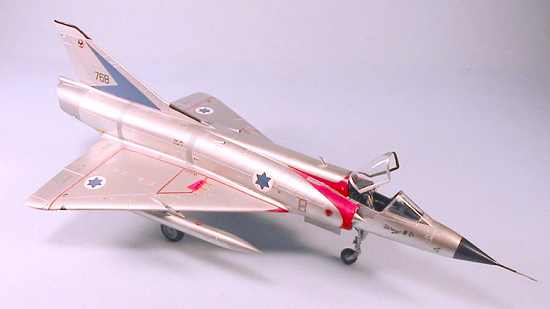 The Israelis
themselves were stunned by their success, with kill ratios exceeding
estimates by 100 percent. They had expected losses of 25-30 percent, but
instead lost 8 aircraft and 5 pilots. Indeed, Israeli HQ refused to
believe the initial reports until Hod had conducted personal debriefings
with mission leaders. During the 100 minutes following the first
strikes, 164 further sorties were flown, destroying another 107 aircraft
for 9 losses.
The Israelis
themselves were stunned by their success, with kill ratios exceeding
estimates by 100 percent. They had expected losses of 25-30 percent, but
instead lost 8 aircraft and 5 pilots. Indeed, Israeli HQ refused to
believe the initial reports until Hod had conducted personal debriefings
with mission leaders. During the 100 minutes following the first
strikes, 164 further sorties were flown, destroying another 107 aircraft
for 9 losses.
Of 420 aircraft in the Egyptian Air Force that morning, 286 were destroyed, along with the loss of nearly one-third of their crews. Thirteen bases were rendered inoperable, along with 23 radar stations and AAA sites. At 1035, Hod turned to Moshe Dayan and reported “The Egyptian Air Force has ceased to exist.”
As Egyptian General Zaki put it: “Israel spent years preparing for this war, whereas we prepared for parades. The drills for the annual Revolution Day parade went on for weeks, while there were no preparations for war.”
During the remaining five days of combat, Mirages would shoot down nearly all Egyptian, Syrian and Jordanian aircraft which managed to get airborne. In the War of Attrition that would follow and then in the Yom Kippur War of 1973, more aces would fly the Mirage III than any fighter since the F-86 Sabre.
The Six Day War is the event which created the contemporary Middle East. An Israeli friend of mine - who participated in the battle of Jerusalem - recalls that when he stood at the Wailing Wall for the first time, his prayer was “God help us, we’ve won.”
Thirty-seven years later, the shock wave of the Six Day War still rattles governments around the world.
|
THE KIT |
There have been several attempts to model the Mirage III over the 40 years since it first appeared. In 1/48 there were kits by Fujimi and Heller that were actually 1/50 - the Fujimi kit is still marketed by Academy - that came out in the 1970s. In the 1980s Heller released a 1/48 kit that could be built - with considerable effort expended by the modeler if accuracy was a desire - as either the single seat Mirage IIIC or the two-seat Mirage IIIB. ESCI released a series of Mirages beginning in the late 1970s which have slowly become available again in re-release from Italerei. None of these have been really accurate, leaving much to be desired in detail and in accuracy of overall shape.
Eduard’s Mirage was announced a year ago, and then delayed for a year with the company saying “we want to get it right.” Well, Bravo to Eduard for taking this route, because this first of what will obviously be an entire series of Mirages finally “gets it right” as regards detail, outline accuracy, and quality of production design!
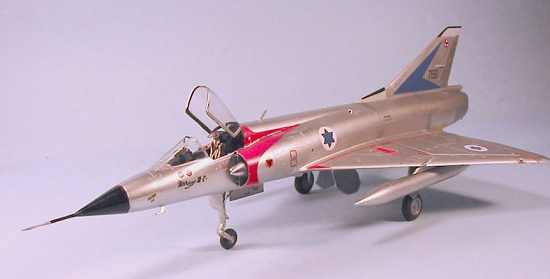 With well over
100 cleanly-molded parts in light grey, the kit offers all the detail a
modeler could desire. The cockpit is simple, but Mirage cockpits are
simple, and since they are almost all painted black the detail that is
there will be more than enough for all but the most
far-gone-in-their-addiction resinaholics. The six part seat looks to
make up into an accurate Martin-Baker seat, with photo-etch seatbelts
provided. The kit also provides a molded lead weight to fit inside the
radome nose, so nose-sitting will not be a problem.
With well over
100 cleanly-molded parts in light grey, the kit offers all the detail a
modeler could desire. The cockpit is simple, but Mirage cockpits are
simple, and since they are almost all painted black the detail that is
there will be more than enough for all but the most
far-gone-in-their-addiction resinaholics. The six part seat looks to
make up into an accurate Martin-Baker seat, with photo-etch seatbelts
provided. The kit also provides a molded lead weight to fit inside the
radome nose, so nose-sitting will not be a problem.
A full suite of the various missiles carried by the Mirage III is provided in the kit.
If one didn’t have the box and instructions to inform them who produced the kit, it could be mistaken for something from Hasegawa or Tamiya in terms of molding quality. I have just received the Hasegawa A-4M Skyhawk this week, and this Mirage kit is every bit as good as that. My only complaint is that the canopy has some distortion, which will detract from the overall look if it is assembled closed.
Decals are provided for five aircraft - two in overall silver from the 1967 war and the other three in camouflage. All of the aircraft are MiG-killers, with one having an impressive score of 13. A separate sheet provides all the stenciling and other markings for the aircraft. There are also express masks for the canopy and for the red markings around the intakes if one opts not to use the decals provided for these.
The sheets also provide the identification triangles used on Mirages after they were camouflaged. Perhaps someone more knowledgeable than I can comment on the accuracy of the colors, because everything I’ve seen shows these were orange and black, not yellow and black as they are on the sheet.
|
CONSTRUCTION |
The Mirage puts
Eduard up with Hasegawa in terms of production design and quality.
I t is not without fault, though the faults are small,
and easily resolved with an application of “some modeling skill
required.” The instructions are clear and easily followed, and there are
no major glitches to be found. If there is a complaint to be had, it is
that the engraved panel detail is a bit light, making it easily lost if
one is not very good at assembling the major parts without seams and
ridges that require putty and sanding to fix.
t is not without fault, though the faults are small,
and easily resolved with an application of “some modeling skill
required.” The instructions are clear and easily followed, and there are
no major glitches to be found. If there is a complaint to be had, it is
that the engraved panel detail is a bit light, making it easily lost if
one is not very good at assembling the major parts without seams and
ridges that require putty and sanding to fix.
That said,
when I build my next one, I will pay closer attention to the wing
assembly. The upper wing includes the entire upper and lower leading
edge. If you do not get this joint tight and clean, you stand to loose a
lot of the very nice surface
 detail on the lower surface of the wing. I
recommend you carefully test-fit the upper and lower parts, and sand down
the interior of the leading edge of the lower wing part, to insure a
tight fit; doing that will mean you don’t have to apply any Mr. Surfacer
to the seam, and then have to rescribe detail lost in sanding things
smooth. Also, if one gets the upper wing-to-fuselage joint as clean as
possible to insure good fit, you will not end up using Mr. Surfacer
there, as I did. I think if you cut off the alignment pins in the
fuselage halves that you can minimize any centerline seam to clean up.
Unfortunately, due to the single-piece design of the vertical fin, you
aren’t going to escape having to deal with the joint of
fin-to-left-fuselage half; if, however, you have trimmed off the
alignment pins and are very careful in assembling the fuselage halves,
you may be able to minimize that.
detail on the lower surface of the wing. I
recommend you carefully test-fit the upper and lower parts, and sand down
the interior of the leading edge of the lower wing part, to insure a
tight fit; doing that will mean you don’t have to apply any Mr. Surfacer
to the seam, and then have to rescribe detail lost in sanding things
smooth. Also, if one gets the upper wing-to-fuselage joint as clean as
possible to insure good fit, you will not end up using Mr. Surfacer
there, as I did. I think if you cut off the alignment pins in the
fuselage halves that you can minimize any centerline seam to clean up.
Unfortunately, due to the single-piece design of the vertical fin, you
aren’t going to escape having to deal with the joint of
fin-to-left-fuselage half; if, however, you have trimmed off the
alignment pins and are very careful in assembling the fuselage halves,
you may be able to minimize that.
As with virtually any Eduard kit, there is one place on this kit where the parts just really don’t want to fit cleanly, and that is the forward section of the one piece lower wing part, which includes the nose wheel well. Aligning that part with the fuselage in that region and the intakes is going to result in a need for Mr. Surfacer long those seams to a greater or lesser degree depending on the quality of your assembly, and some rescribing. Fortunately that is all on lower surfaces, so it won’t be so apparent in the final result.
All this talk about getting the assembly as clean as possible is of particular importance if you are thinking of doing one of the two natural metal finish airplanes. I sanded with very fine grit and then polished out the model overall, to prepare it for the natural metal finish I had planned.
 There are
several small antennas that need to be attached during main assembly. To
lessen the likelihood of knocking them off later, I also assembled the
landing gear legs, so the model would be raised off the work table,
keeping the antennas away from the tabletop.
There are
several small antennas that need to be attached during main assembly. To
lessen the likelihood of knocking them off later, I also assembled the
landing gear legs, so the model would be raised off the work table,
keeping the antennas away from the tabletop.
The Eduard photo-etch seatbelts and ejection handles were used on the ejection seat, resulting in a very good-looking addition to a very plain black cockpit. The decals provided for instrumentation are more than sufficient to provide necessary detail for this area.
|
COLORS & MARKINGS |
Painting:
I am a fan of deltas for their shape. To me, a disruptive multi-color camouflage detracts from the elegance of line of the airplane being modeled, so I like to do my deltas in one main color whenever possible. The Israeli Mirages used in the Six Day War were all in natural metal finish, and this is what I went with.
 First, I
painted the zinc chromate area under the rear fuselage (where the rocket
mount was removed), as well as the antenna areas on the fin tip and
forward dorsal fin, as well as the radome. These were then masked off,
and I misted on SNJ “Aluminum” paint as both a primer for Alclad and a
final color itself. When this was dry, I masked off the wings and the
central area of the vertical fin, and painted the fuselage with Alclad II
“Polished Aluminum.” I then masked off the rear fuselage around the
exhaust, and the fuselage frames, and painted those areas with Model
Master Metalizer “Stainless Steel.” When that dried, I unmasked the
model, and used SNJ polishing powder to create a different tonal color to
the elevons and rudder. The result is very subtle but noticeable in
person, creating a multi-hue natural metal finish.
First, I
painted the zinc chromate area under the rear fuselage (where the rocket
mount was removed), as well as the antenna areas on the fin tip and
forward dorsal fin, as well as the radome. These were then masked off,
and I misted on SNJ “Aluminum” paint as both a primer for Alclad and a
final color itself. When this was dry, I masked off the wings and the
central area of the vertical fin, and painted the fuselage with Alclad II
“Polished Aluminum.” I then masked off the rear fuselage around the
exhaust, and the fuselage frames, and painted those areas with Model
Master Metalizer “Stainless Steel.” When that dried, I unmasked the
model, and used SNJ polishing powder to create a different tonal color to
the elevons and rudder. The result is very subtle but noticeable in
person, creating a multi-hue natural metal finish.
Decals:
I chose to do the Mirage of 119 Squadron, which matches it up with the 119 Squadron P-51D of the 1956 Suez War in my collection.
The kit decals are excellent. They are thin, and have no excess carrier film, an important point for doing a NMF model, since I didn’t want to have to apply a sealer to get rid of the tonal difference that would be created by the decal film. The sheets provide all national and unit markings, and all of the stenciling.
|
CONCLUSIONS |
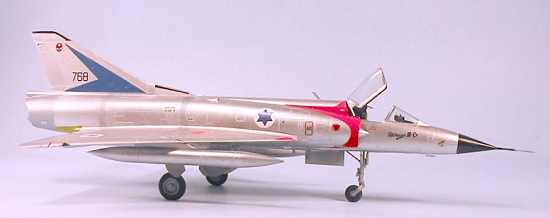 The Mirage is
one of that small company of “immortals” which were both technologically
and operationally significant and successful in the role of a fighter in
the wars of the 20th Century, and certainly deserving of a
place in any collection of important aircraft. Eduard’s first foray into
modern aircraft is a resounding success. This is the most accurate kit
of the Mirage III yet produced, and the resulting model is very
striking. Eduard has let it be known that others in the series will be
produced down the line, so those wanting the IIIE, IIIO, IIIR and Mirage
5 need only take a deep breath, sit back and exercise patience in order
to have their wishes met.
The Mirage is
one of that small company of “immortals” which were both technologically
and operationally significant and successful in the role of a fighter in
the wars of the 20th Century, and certainly deserving of a
place in any collection of important aircraft. Eduard’s first foray into
modern aircraft is a resounding success. This is the most accurate kit
of the Mirage III yet produced, and the resulting model is very
striking. Eduard has let it be known that others in the series will be
produced down the line, so those wanting the IIIE, IIIO, IIIR and Mirage
5 need only take a deep breath, sit back and exercise patience in order
to have their wishes met.
Review kit courtesy of Eduard.
|
REFERENCES |
Gunston, Bill: “Dassault Mirage III and 5" in “Early Supersonic Fighters of the West;” New York: Scribner and Sons; 1975.
Oren, Michael B.: “Six Days of War: June 1967 and the Making of the Modern Middle East;” London: Oxford University Press, 2003.
If you would like your product reviewed fairly and quickly by a site that has over 250,000 visitors a month, please contact me or see other details in the Note to Contributors.